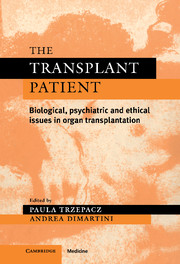Book contents
- Frontmatter
- Contents
- List of contributors
- Preface
- 1 The mystique of transplantation: biologic and psychiatric considerations
- 2 Psychosocial screening and selection of candidates for organ transplantation
- 3 Psychosocial issues in living organ donation
- 4 Quality of life in organ transplantation: effects on adult recipients and their families
- 5 Quality of life of geriatric patients following transplantation: short- and long-term outcomes
- 6 Cognitive assessment in organ transplantation
- 7 Pharmacologic issues in organ transplantation: psychopharmacology and neuropsychiatric medication side effects
- 8 Alcoholism and organ transplantation
- 9 Ethics and images in organ transplantation
- 10 Psychoneuroimmunology and organ transplantation: theory and practice
- 11 Pediatric transplantation
- 12 Current trends and new developments in transplantation
- Index
3 - Psychosocial issues in living organ donation
Published online by Cambridge University Press: 14 September 2009
- Frontmatter
- Contents
- List of contributors
- Preface
- 1 The mystique of transplantation: biologic and psychiatric considerations
- 2 Psychosocial screening and selection of candidates for organ transplantation
- 3 Psychosocial issues in living organ donation
- 4 Quality of life in organ transplantation: effects on adult recipients and their families
- 5 Quality of life of geriatric patients following transplantation: short- and long-term outcomes
- 6 Cognitive assessment in organ transplantation
- 7 Pharmacologic issues in organ transplantation: psychopharmacology and neuropsychiatric medication side effects
- 8 Alcoholism and organ transplantation
- 9 Ethics and images in organ transplantation
- 10 Psychoneuroimmunology and organ transplantation: theory and practice
- 11 Pediatric transplantation
- 12 Current trends and new developments in transplantation
- Index
Summary
Introduction
The theme of the gift, of freedom and obligation in the gift, of generosity and self–interest in giving, reappear in our own society like the resurrection of a dominant motif long forgotten. (Marcel Mauss, The Gift, 1954.)
The living donation of organs or bone marrow entails significant sacrifice on the part of the donor and can be legitimately classified as a unique and important form of gift giving. There are, however, features of organ donation that distinguish it from other types of gift giving, including its impersonal context, few if any penalties for refusing to donate (particularly for unrelated donors), no expectation of reciprocal gift giving, and consequences of the gift to prolong life (Titmuss 1972). Volunteer donors undergo significant discomfort, inconvenience, and physical risk to provide such gifts, suggesting uniqueness to the psychological issues surrounding the decision to donate, and factors that impact on donors' postdonation physical and psychological experiences.
Composing a coherent summary of current research and issues involved in living organ donation is a daunting task. First, unlike the case of the organ recipient, whose condition is dire regardless of what type of organ he or she is receiving, the physical risk of organ donation varies greatly across organ types. Bone marrow donation is minimally invasive and involves a regenerating body part, while kidney, liver lobe, and lung lobe donations require major surgery to remove organ or organ portions that do not regenerate (except some liver tissue).
- Type
- Chapter
- Information
- The Transplant PatientBiological, Psychiatric and Ethical Issues in Organ Transplantation, pp. 42 - 66Publisher: Cambridge University PressPrint publication year: 2000
- 12
- Cited by



